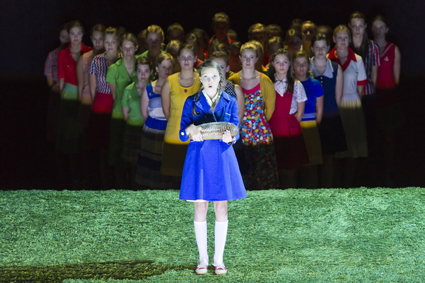Not so innocent
Jessica Sabatini: Heiner Goebbels, When The Mountain Changed Its Clothing

When the Mountain Changed Its Clothing, Heiner Goebbels, Melbourne International Arts Festival
photo Wonge Bergmann for the Ruhrtriennale.
When the Mountain Changed Its Clothing, Heiner Goebbels, Melbourne International Arts Festival
“WHAT DO LITTLE GIRLS DREAM OF?” “KNIVES, AND BLOOD,” INTONES CARMINA SLOVENICA, A SLOVENIAN CHOIR COMPRISING 40 YOUNG WOMEN AGED 10 TO 18, UNDER THE DIRECTION OF HEINER GOEBBELS.
This blend of innocence and darkness infuses all of When the Mountain Changed its Clothing, a work devised in 2012 that continues to tour the international festival circuit.
There are the vocal textures of the choir, so often in minor keys, droning, warping, sometimes with a hint of horror. Yet these sounds are generated by seeming ingénues in pastel 50s-style skirts and blouses, holding fluffy toys.
Then there is the set, with its square of bright, fake lawn centre-stage, backed by painted nature scenes successively unveiled throughout: a kind of three-dimensional storybook completed by tableaux vivants. But the texts delivered here (ranging from Adelbert Stifter to Ian McEwan to Gertrude Stein) are probing, absurdist dialogues, often interrogations as the choir crowds around a girl or two to examine mortality and lay bare the passage of time.
Despite their surreal and luminous look, many scenes have an earthy, old world feel. A girl visits a neighbour bearing a loaf of bread. Two others sit by a campfire with a small roast on a spit. Two others sit and sew while discussing poverty. At least, at a glance they seem to be sewing, with innate grace and efficiency. But in fact one is eviscerating her teddy bear and the other is bundling the white stuffing into clouds on strings, which they then drift across the lawn while the rest of the choir sings. The loss of innocence is implied in all of this. But so too is the role of youth as the voice of wisdom.
Still another facet of innocence shines in the exuberance of the girls’ physicality. They bustle round the stage like worker bees, rearranging the set between scenes. At one point all 40 gather on the lawn to chant and clap and yelp in vigorous syncopation; and they bring full-throated verve to choral works by Slovenian composers along with Brahms, Sarah Hopkins and Yugoslavian propagandists. Even when a chthonic chill hangs around the fake lawn, their vivacity remains intact. There is vitality, without naivety, in their dramatic presence.
They’re not ingénues after all, I think to myself in those moments. More like sibyls. Poised on the threshold of womanhood, as future mothers they stare beyond the threshold of death. Into history too: “Do you remember when your mother was a little girl?” they ask. This ‘tracking’ and flexing of represented time is the most haunting aspect of the work.
Visually, time’s changes trickle early in the piece, through costuming. Appearing first in contemporary dress, the ensemble gradually and seamlessly rolls back generations, with just a few performers changing at a time. In a group this size, there’s no way to notice individual changes. Instead we witness this mass effect as an unveiling of years, a slow emergence—wonder, an allusion to the title?
When the Mountain Changed its Clothing has no narrative or sense of linearity. Rather, its unfolding feels kaleidoscopic. And in its shifting scenes we watch the play of colour, light and darkness that is present in life’s mysteries and elemental changes.
Melbourne International Arts Festival, Heiner Goebbels and Vocal Theatre Carmina Slovenica, State Theatre, Arts Centre Melbourne, 23-26 Oct
RealTime issue #124 Dec-Jan 2014 pg. 16






